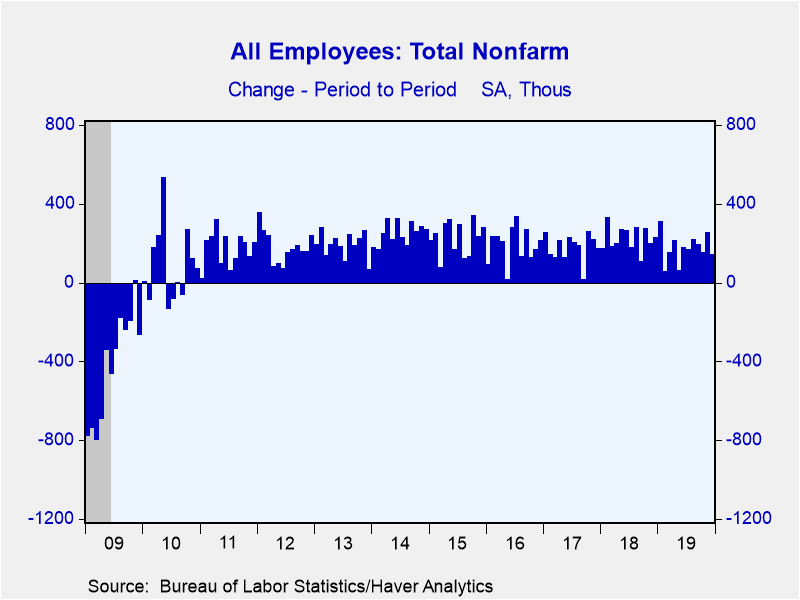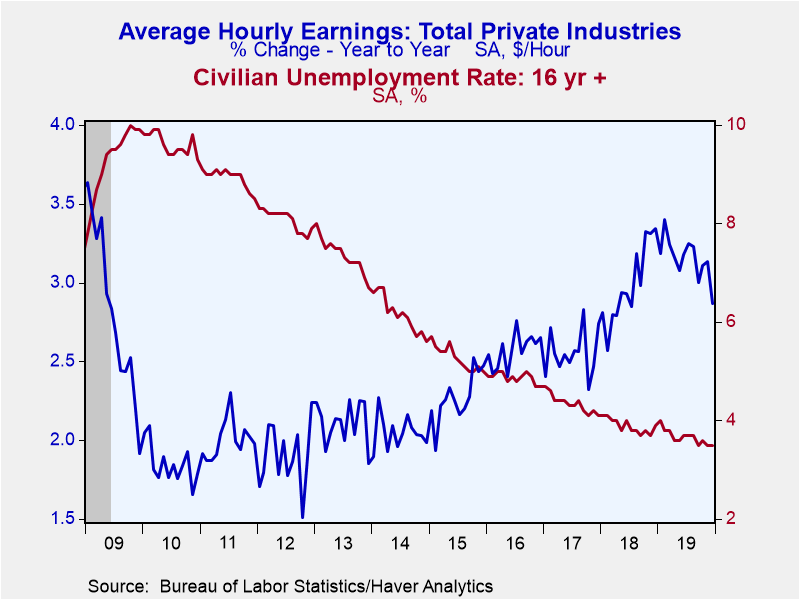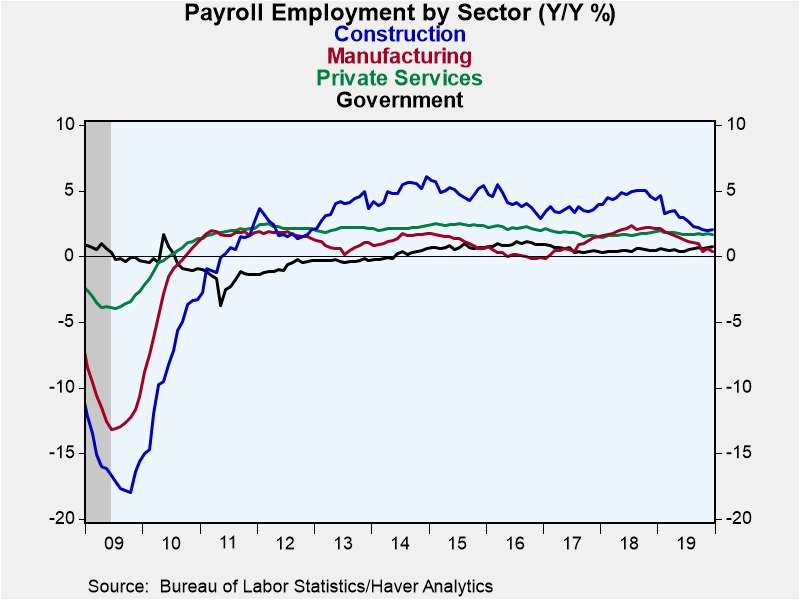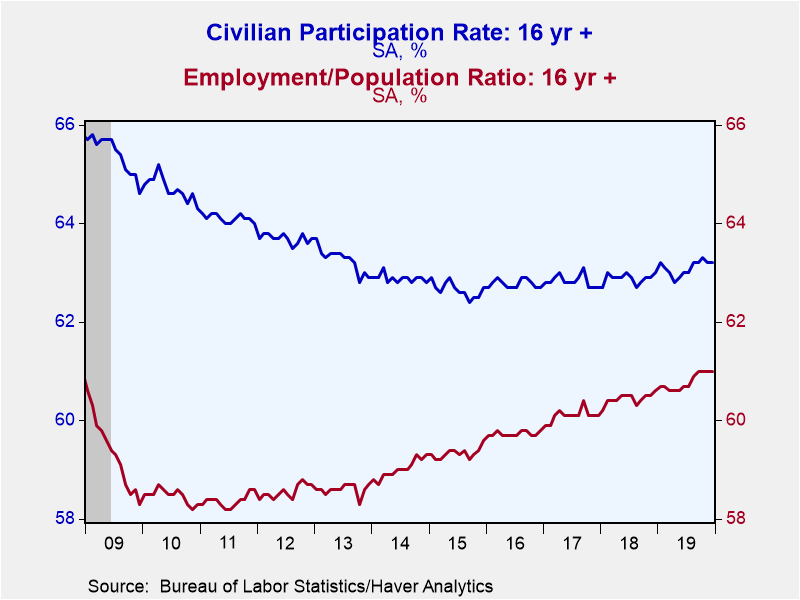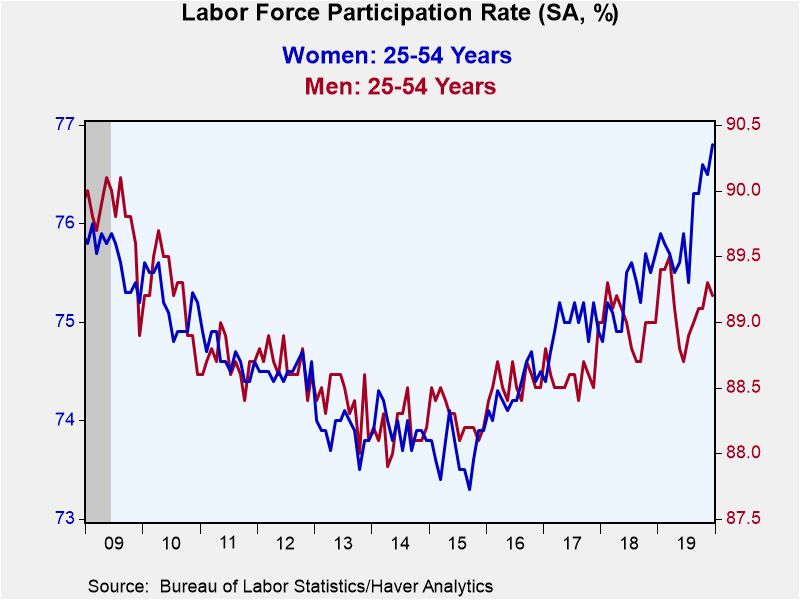 Global| Jan 10 2020
Global| Jan 10 2020U.S. Nonfarm Payroll Increase & Wage Gains Disappoint; Jobless Rate Steady
by:Tom Moeller
|in:Economy in Brief
Summary
The labor market ended 2019 with diminished growth. Nonfarm payroll employment increased 145,000 (1.4% y/y) during December after rising 256,000 in November, revised from 266,000. October employment rose 152,000, revised from 156,000. [...]
The labor market ended 2019 with diminished growth. Nonfarm payroll employment increased 145,000 (1.4% y/y) during December after rising 256,000 in November, revised from 266,000. October employment rose 152,000, revised from 156,000. A 178,000 increase had been expected in the Action Economics Forecast Survey. For all of last year, payrolls overall rose on average 176,000 per month after a 223,000 monthly average in 2018. It was the weakest December-to-December change since 2011.
Average hourly earnings in the private sector edged 0.1% higher last month following a 0.3% November increase, revised from 0.2%. A 0.3% rise had been expected. Growth during the last twelve months of 2.9% remained below the recent 12-month peak of 3.4% logged in February.
The unemployment rate held steady at an expected 3.5% in December after falling from 3.6% in October. Employment in the household survey rose 267,000 (1.3% y/y) and the labor force increased 209,000 (0.9% y/y). The overall jobless rate, including those who were marginally attached or working part-time for economic reasons, declined to 6.7% from October's 7.0%, the lowest level since data began in 1994.
From the payroll survey, the 145,000 gain in employment reflected a 20,000 worker increase in construction employment which was the strongest gain since April. A 12,000 decline in factory sector payrolls offset this rise, making it the second decline in three months. The October and November results were distorted by the strike at General Motors. Mining & logging sector payrolls declined 9,000 (-2.9% y/y) and have been falling since early last year.
In the private service sector, payrolls increased 140,000, the weakest increase since July. Employment in trade, transportation & utilities increased 40,000 (0.5% y/y) after a 4,000 decline. Retail trade employment gained 41,200 (0.1% y/y) after falling 14,100. A 40,000 employment increase (2.5% y/y) also was logged by the leisure & hospitality sector, as it followed four straight months of strong increase. Education & health care employment rose 36,000 (2.7% y/y), half the prior month's rise. Financial sector employment rose 6,000 (1.4% y/y). Professional & business services employment rose a weakened 10,000 (1.9% y/y), an increase following 53,000 growth in November. Professional & technical services jobs rose 9,200 (2.9% y/y) after a 33,600 rise. Temporary help employment rose a fairly steady 6,400 (-0.3% y/y). Employment in the information sector rose 3,000 (0.6% y/y) after an 8,000 rise.
Average hourly earnings inched 0.1% higher last month following two months of 0.3% increase. The 2.9% y/y gain compared to a high of 3.4% in February. The construction sector experienced a great slowdown in y/y earnings growth to 2.3% from 3.8% at the end of 2018. Private services earnings growth also slowed to 2.9% from 3.5% in December 2018 as earnings in the information sector grew just 2.5% y/y after 2018 growth of 6.3%. Financial services earnings growth also slowed to 2.8% from 3.9% a year earlier. Earnings growth slowed to 1.8% y/y in education & health services. Annual growth in leisure & hospitality slowed to 3.1% y/y in 2019 from 3.6% in 2018. To the upside, factory sector earnings grew 3.0% y/y, an acceleration from 2.0% in 2018. Professional & business services earnings growth picked up to 3.7% y/y, a ten year high.
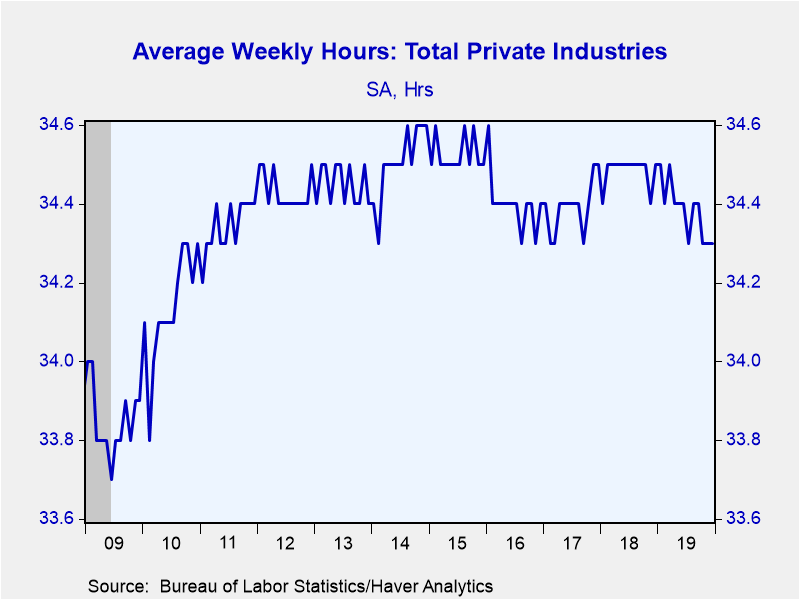 The length of the average workweek held steady at 34.3 hours
for the third straight month. That was down from the 34.5 hour workweek as of
March. Hours shortened to 45.7 in the mining & logging sector from 46.4 and
in manufacturing held at 40.5 hours. Construction sector hours fell to 39.0 from
39.4 nine months earlier. Service sector hours held recently at 33.2 but that
was below 2018 high of 33.4. Hours in financial services were reduced at 37.6 as
they were in professional & business services at 36.1. Leisure &
hospitality hour fell to 25.8, but they held at a record 33.1 in education &
health services.
The length of the average workweek held steady at 34.3 hours
for the third straight month. That was down from the 34.5 hour workweek as of
March. Hours shortened to 45.7 in the mining & logging sector from 46.4 and
in manufacturing held at 40.5 hours. Construction sector hours fell to 39.0 from
39.4 nine months earlier. Service sector hours held recently at 33.2 but that
was below 2018 high of 33.4. Hours in financial services were reduced at 37.6 as
they were in professional & business services at 36.1. Leisure &
hospitality hour fell to 25.8, but they held at a record 33.1 in education &
health services.
From the household survey of employment, the steady 3.5% unemployment rate and the strong gain in the labor force reflected a steady labor force participation rate of 63.2%. That was up, nevertheless, from the September 2015 low of 62.4%. The teenage participation rate declined to 35.7%, but for those aged 20-24 it rose to 71.8%. For workers aged 25-54, the rate increased to a cycle high of 82.9%. For men in that age bracket, the rate eased slightly to 89.2%. For women of that age, however, it surged to 76.8%, the highest rate since 2001. It increased from an average 73.7% during all of 2015. For workers aged 55 & over, the participation rate was steady m/m at 40.3%, but still was increased from 30.0% in 1995. The employment/population ratio of 61.0%k was increased from 58.4% in 2011.
The teenage unemployment rate eased to 12.6%, well below the 25.9% averaged in 2010. The rate for workers aged 20-24 of 6.3% was lower than the 15.5% average in 2010. For workers aged 25-54, the rate of 3.0% was down from 8.6% in 2010. For those over 55, the jobless rate of 2.4% compared to 7.0% in 2010.
By education attainment, unemployment of workers without a high school diploma was 5.2%. High school graduates without a college degree were 3.7% unemployed and those with some college but no degree were 2.7% without work. College graduates were 1.9% unemployed.
The labor market data are contained in Haver's USECON database. Detailed figures are in the EMPL and LABOR databases. The expectations figures are in the AS1REPNA database.
| Employment: (SA, M/M Change, 000s) | Dec | Nov | Oct | Dec Y/Y | 2019 | 2018 | 2017 |
|---|---|---|---|---|---|---|---|
| Payroll Employment | 145 | 256 | 152 | 1.4% | 1.6% | 1.7% | 1.6% |
| Previous Estimate | -- | 266 | 156 | -- | -- | -- | -- |
| Manufacturing | -12 | 58 | -45 | 0.4 | 1.2 | 2.0 | 0.7 |
| Construction | 20 | 2 | 14 | 2.0 | 2.8 | 4.6 | 3.6 |
| Private Service-Producing | 140 | 191 | 193 | 1.7 | 1.7 | 1.7 | 1.8 |
| Government | 6 | 13 | -12 | 0.7 | 0.5 | 0.4 | 0.5 |
| Average Weekly Hours - Private Sector | 34.3 | 34.3 | 34.3 | 34.5 | 34.4 | 34.5 | 34.4 |
| Private Sector Average Hourly Earnings (%) | 0.1 | 0.3 | 0.3 | 2.9 | 3.2 | 3.0 | 2.6 |
| Unemployment Rate (%) | 3.5 | 3.5 | 3.6 | 3.9 | 3.7 | 3.9 | 4.3 |
Tom Moeller
AuthorMore in Author Profile »Prior to joining Haver Analytics in 2000, Mr. Moeller worked as the Economist at Chancellor Capital Management from 1985 to 1999. There, he developed comprehensive economic forecasts and interpreted economic data for equity and fixed income portfolio managers. Also at Chancellor, Mr. Moeller worked as an equity analyst and was responsible for researching and rating companies in the economically sensitive automobile and housing industries for investment in Chancellor’s equity portfolio. Prior to joining Chancellor, Mr. Moeller was an Economist at Citibank from 1979 to 1984. He also analyzed pricing behavior in the metals industry for the Council on Wage and Price Stability in Washington, D.C. In 1999, Mr. Moeller received the award for most accurate forecast from the Forecasters' Club of New York. From 1990 to 1992 he was President of the New York Association for Business Economists. Mr. Moeller earned an M.B.A. in Finance from Fordham University, where he graduated in 1987. He holds a Bachelor of Arts in Economics from George Washington University.


